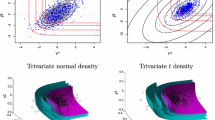Abstract
The estimation and management of risk is an important and complex task faced by market regulators and financial institutions. Accurate and reliable quantitative measures of risk are needed to minimize undesirable effects on a given portfolio fromlarge fluctuations in market conditions. To accomplish this, a series of computational tools has beendesigned, implemented, and incorporated into MatRisk, an integratedenvironment for risk assessment developed in MATLAB. Besides standard measures, such as Value at Risk(VaR), the application includes other more sophisticated risk measures that address the inability of VaRproperly to characterize the structure of risk. Conditionalrisk measures can also be estimated for autoregressive models with heteroskedasticity, including some novel mixture models. These tools are illustrated with a comprehensive risk analysis of the Spanish IBEX35 stock index.
Similar content being viewed by others
References
Artzner, P., Delbaen, F., Eber, J.-M., and Heath, D. (1997). Thinking coherently. Risk, 10(11), 68-71.
Artzner, P., Delbaen, F., Eber, J.-M., and Heath, D. (1999). Coherent measures of risk. Mathematical Finance, 9(3), 203-228.
Bollerslev, T. (1986). Generalized autoregressive conditional volatility. Journal of Econometrics, 31, 307-327.
Danielsson, J., Hartmann, P., and de Vries, C. (1998). The cost of conservatism. Risk, (January), 101-103.
Eberlein, E. and Keller, U. (1995). Hyperbolic distributions in finance. Bernoulli, 1, 281-299.
Embrechts, P., Kluplelberg, C., and Mikosch, T. (1997). Modelling Extremal Events for Insurance and Finance. Springer-Verlag, Berlin.
Embrechts, P., Resnick, S., and Samorodnitsky, G. (1998). Living on the edge. Risk, (January), 96-100.
Engle, R.F. (1982). Autoregressive conditional heteroskedasticity wity estimates of the variance of U.K. inflation. Econometrica, 50, 987-1008.
Hamilton, J.D. (1991). A quasi-Bayesian approach to estimating parameters for mixtures of normal distributions. Journal of Business and Economic Statistics, 9(1), 27-39.
Hamilton, J.D. (1994). Time Series Analysis. Princeton University Press, Princeton, NJ.
Hull, J. and White, A. (1997). Evaluating the impact of kurtosis and skewness on derivative prices. NetExposure, 3, 81-90.
Hull, J. and White, A. (1998). Value at risk when daily changes in market variables are not normally distributed. Journal of Derivatives, 5(3), 9-19.
Jarrow, R. (ed.) (1998). Volatility: New Estimation Techniques for Pricing Derivatives. Risk Books, London.
Jorion, P. (1997). Value at Risk: The New Benchmark for Controlling Market Risk. McGraw-Hill, New York.
Kuchler, U., Neumann, K., Soerensen, M., and Streller, A. (1994). Stock returns and hyperbolic distributions. Sonderforschungsbereich 373, Humboldt-Universtat zu Berlin, (23), 1-18.
McCulloh, J.H. (1996). Financial applications of stable distributions. In G.S. Maddala and C.R. Rao (eds.), Statistical Methods in Finance, Handbook of Statistics Vol. 14. North Holland.
Ormoneit, D. and Neuneier, R. (1999). Conditional value at risk. In Y.S. Abu-Mostafa, A.W. Lo, and A.S. Weigend (eds.), Proceedings of the Sixth International Conference in Computational Finance. MIT Press, Cambridge, U.S.A.
Press, W., Teukolsky, W.T., Vetterling, S.A., and Flannery, B. (1993). Numerical Recipes in C. Cambridge University Press, Cambridge.
Weigend, A.S., Mangeas, M., and Srivastava, A.N. (1995). Nonlinear gated experts for time series: Discovering regimes and avoiding overfitting. International Journal of Neural Systems, 6, 373-399.
Wong, C.S. and Li, W.K. (2000). On a mixture autoregressive model. Journal of the Royal Statistical Society B, 62, 95-115.
Zeevi, A.J., Meir, R., and Adler, R.J. (1999). Non-linear models for time series using mixtures of autorregressive models. Preprint.
Author information
Authors and Affiliations
Rights and permissions
About this article
Cite this article
Suárez, A., Carrillo, S. Computational Tools for the Analysis of Market Risk. Computational Economics 21, 153–172 (2003). https://doi.org/10.1023/A:1022267720606
Issue Date:
DOI: https://doi.org/10.1023/A:1022267720606




